The first steps towards inter-confessionnal ecumenism
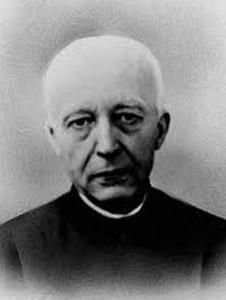 Abbot Paul Couturier (1881-1953)
Abbot Paul Couturier (1881-1953)
 Abbaye des Dombes
Abbaye des Dombes
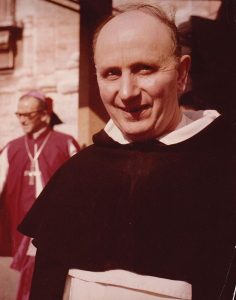 Father Yves Congar at the Second Vatican Council in 1964 © Wikimedia Commons
Father Yves Congar at the Second Vatican Council in 1964 © Wikimedia Commons
In the interwar period several initiatives enabled constructive inter-confessionnal discussions.
For instance, in 1936 Abbot Paul Couturier initiated and organised a Week of Universal prayer for unity, which was not about criticising the separated Churches, but demanding universality. To strengthen the initiative he founded the Dombes Group in 1937. Its aim was to reflect on contentious doctrinal points, such as the Eucharist or the authority of ministries, to find paths of convergence.
The Dominican Father Yves Congar (1904-1995), who took part in the activities of the French Federation of Christian Students Associations, was very early on involved in reflecting on ecumenism and inter-confessional obstacles. In his book, published in 1937 Christians disunited, he developed a thesis that immediately stood out – according to him, if the Catholic Church was the only place of visible unity, it could only be proved by reforming and understanding what Luther’s Reformation meant.
Father Congar was one of the theologians chosen by Pope John XXIII to write the preparatory materials of Vatican II works.
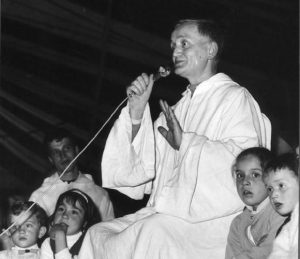 Brother Roger Schutz, prior of Taizé © Fédération Protestante de France
Brother Roger Schutz, prior of Taizé © Fédération Protestante de France
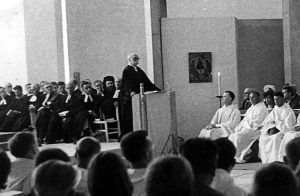 Pastor Boegner preaching in Taizé church © Fédération Protestante de France
Pastor Boegner preaching in Taizé church © Fédération Protestante de France
The fraternal Community in Taizé was founded by pastors Roger Schütze (1915-2005) and Max Thurian (1921-1996) in a small village of the Saône et Loire region (not far from the Cluny Abbey) in 1944. It multiplied inter-confessionnal initiatives towards the Catholic Church. First they sought involvement with the local Catholic parishes, taking part in various community-based actions, agricultural cooperative, health centre, etc.
Upon the opening of the Vatican II council, the community intensified contacts with Council fathers and Roman authorities, and even established some brothers in Rome.
After Vatican II, common projects
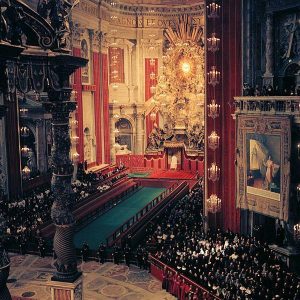 Second Vatican Council (1962-1965) © Lothar Wolleh
Second Vatican Council (1962-1965) © Lothar Wolleh
 Pope Paul VI and the Archbishop of Canterbury Michael Ramsey (1966) © ANCS
Pope Paul VI and the Archbishop of Canterbury Michael Ramsey (1966) © ANCS
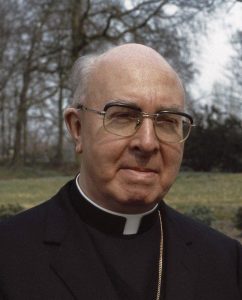 Johannes Willebrands (1909-2006) © Wikimedia Commons
Johannes Willebrands (1909-2006) © Wikimedia Commons
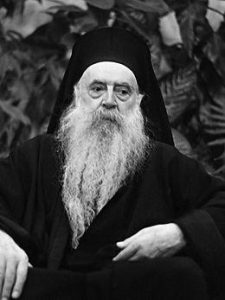 Patriarche Athénagoras Ier de Constantinople (1886-1972) © Wikimedia Commons
Patriarche Athénagoras Ier de Constantinople (1886-1972) © Wikimedia Commons
It was obviously after Vatican II council, to which all bishops were summoned, that new prospects opened up. It was announced by John XXIII in 1959 after the Week of universal prayer for Unity, through a message to which the other communities responded. Soon after they were asked to send observers. One of them was Pastor Hébert Roux (1908-1980) who represented the universal Reformed Alliance.
In 1961 the Vatican set up a Secretariat for Promoting Christian Unity under the responsibility of two men of openness and dialogue, namely Cardinal Béa (1881-1968), assisted by Cardinal Willebrands (1909-2006). Thereupon two very significant events took place:
- In 1964 a solemn meeting between Paul VI and the ecumenical Orthodox patriarch of Constantinople Athenagoras was organised; a prelude to lifting the anathemas ( in 1965) that had provoked the 1054 schism,.
- In 1966 the meeting of Paul VI and the Archbishop of Canterbury, Michael Ramsey began a dialogue between the Anglican Church and the Catholic Church, which wasn’t possible since the 1534 schism caused by Henry the VIIIth.
A rich collaborative progression was launched:
- In 1966 the first step was taken with the creation of the mixed work Group (Catholic, Protestant, Anglican, Orthodox).
- In 1968 during the Assembly of the ecumenical Council of Churches in Uppsala (Sweden) Jesuit father Roberto Tucci (1921-2015), later made a cardinal, was allowed to make a public speech in a personal capacity: Ecumenical movement, ecumenical Council of Churches and Roman Catholic Church.
- In 1975 the Roman Catholic Church accepted to take full part in the Faith and Order Commission of the WCC. From the collaboration was issued the publication of the document Baptism, Eucharist, Ministry at the Lima conference in 1982.
- Dialogues were organised within Justice and Peace commissions jointly composed in France by the Bishops Conference and the French Protestant Federation.
- The Roman Catholic Church also engaged in a dialogue with the universal Lutheran Federation, and it resulted first in the Declaration on Justification (1999) and then From conflict to communion (2013).
- All the collaborations within local parishes should also be noted: ecumenical groups, exchange of pulpits during the week of prayer for Christian unity, better acknowledgement of mixed marriages.
However the problem of the authority given to ecclesial institutions remain difficult to solve as the Roman Catholic Church and representatives of Protestant and Orthodox Churches have rather divergent views on the subject.